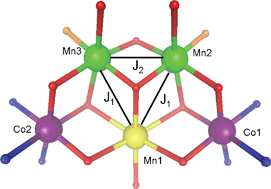Synthetic methods are described that have resulted in the formation of seven heterometallic complexes, all of which contain partially deprotonated forms of the ligand triethanolamine (teaH3). These compounds are [MnIII4CoIII2CoII2O2(teaH2)2(teaH)0.82(dea)3.18(O2CMe)2(OMe)2](BF4)2(O2CMe)2·3.18MeOH·H2O (1), [MnII2MnIII2CoIII2(teaH)4(OMe)2(acac)4](NO3)2·2MeOH (2), [MnIII2NiII4(teaH)4(O2CMe)6]·2MeCN (3), [MnIII2CoII2(teaH)2(sal)2(acac)2(MeOH)2]·2MeOH (4), [MnII2FeIII2(teaH)2(paa)4](NO3)2·2MeOH·CH2Cl2 (5), [MnIIMnIII2CoIII2O(teaH)2(dea)(Iso)(OMe)(F)2(Phen)2](BF4)(NO3)·3MeOH (6) and [MnII2MnIIICoIII2(OH)(teaH)3(teaH2)(acac)3](NO3)2·3CH2Cl2 (7). All of the compounds contain manganese, combined with 3d transition metal ions such as Fe, Co and Ni. The crystal structures are described and examples of ‘rods’, tetranuclear ‘butterfly’ and ‘triangular’ Mn3 cluster motifs, flanked in some cases by diamagnetic cobalt(III) centres, are presented. Detailed DC and AC magnetic susceptibility and magnetization studies, combined with spin Hamiltonian analysis, have yielded J values and identified the spin ground states. In most cases, the energies of the low-lying excited states have also been obtained. The features of note include the ‘inverse butterfly’ spin arrangement in 2, 4 and 5. A S = 5/2 ground state occurs, for the first time, in the MnIII2MnII triangular moiety within 6, the many other reported [Mn3O]6+ examples having S = ½ or 3/2 ground states. Compound 7 provides the first example of a MnII2MnIII triangle, here within a pentanuclear Mn3Co2 cluster.


 Please wait while we load your content...
Please wait while we load your content...